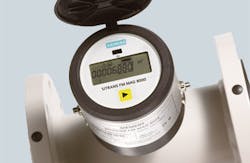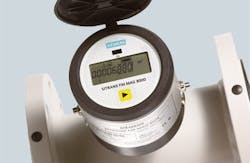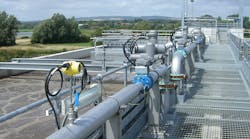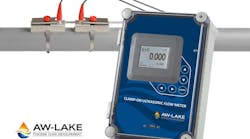For each of two water districts, by modeling the complex water flows involved, operations managers were able to convert the system into smaller, more easily managed zones. Each zone’s flow can be viewed independently. Battery-operated magnetic flowmeters in each zone record information in real time and transmit flow data on a daily basis. Information-technology based automation supports data analysis and identification of heretofore near-undetectable sources of non-revenue water.
Minimizing avoidable water leakage is especially important because, unlike most utilities, the United Water New Rochelle and United Water Westchester districts must purchase — from the New York City Department of Environmental Protection, Westchester Joint Water Works and Aquarion Water — 100 percent of the water it provides to users.
Besides real losses, theft is an additional source of district water loss.
"We documented pressures in each of the zones, as well as demand — including irrigation and metered-consumption demand — expressed as minimum, average and maximum flows. We then set goals for minimizing non-revenue water losses. By reviewing each district meter area’s independent production anomalies, we can address the challenges involved methodically, rather than having crews scattered all over the districts," says Keith Kolkebeck, director, technology solutions, United Water.
On any given day, besides methodically addressing persistent losses and monitoring data, United Water operations managers can home in on any anomalous event, indicated by a changing flow balance within a particular zone. At that point, field personnel can "triangulate," i.e., use instrument data to get an even better idea of where they need to look.
Armed with the instrumentation data, "an experienced field crew then can go to nearby hydrants and listen to the flow," says Lynda DiMenna, United Water’s manager for the two districts. "They know right away if they’re dealing with a leak. Portable instrumentation supports the final steps before starting to dig. Things go faster and fewer dry holes are dug. It’s a much more efficient way to minimize non-revenue water loss."
"This application of battery-operated magnetic flowmeter technology is unique and a significant instance of innovation," says Brian Roughan, a senior account manager with Siemens Industry, which supplied the flowmeters and other instrumentation used in the program. "Other utilities will be doing this in the future."
Zones dictated by water flow pressures
United Water New Rochelle/Westchester’s parent company, United Water, was originally founded as the Hackensack Water Co. in 1869. United Water says it is one of the nation’s leading environmental companies, providing water and wastewater services to more than 5.3 million people in the United States. In addition to owning and operating 16 water and wastewater utilities, United Water operates 84 municipal and industrial water and wastewater systems through innovative public-private partnerships and contract agreements. Its 2013 revenues were $764 million and it is a subsidiary of Suez Environnment.
In Westchester County today, United Water serves about 200,000 people in two districts, referred to as "New Rochelle" and "Westchester" (See diagram).
New Rochelle includes some 426 miles of main water lines and serves about 32,000 customers. Westchester has about 167 miles of main water lines and serves more than 12,000 customers. New Rochelle’s average water flow — greatly influenced week to week by seasonality — is 18 million gallons a day with a maximum flow of 48 million and a minimum of 10 million gallons a day. Westchester’s average flow is 7.6 million gallons a day with a maximum water flow of 10.5 million and a minimum of 5.8 million gallons a day.
The New Rochelle district splits into 11 zones and makes use of 60 battery-operated magnetic flowmeters – invariably referred to as "mag meters" — along with six existing production meters, for pipe diameters that ranged from four to 24 inches. However, flowmeters were specified based not on pipe diameters, but on actual minimum, average and maximum water flows. The Westchester district required only 21 mag meters to accomplish detailed flow monitoring by zone.
Developing the concept and planning the project, from initial discussion to shovel-in-the-ground, took 18 months.
Doing data drill-downs for water flow
Nick Curcio is the non-revenue water manager who built the water flow models that allowed for zoning of the two water districts. "In choosing the zone boundaries we looked at geography and system capacities. We first sought to minimize the number of closed-boundary valves, as each had to be isolated from the others while maintaining needed capacity. Once the zone boundaries were established hydraulically, we installed a flowmeter wherever it wasn’t feasible to close a valve to prevent unmetered water flow between zones."
While Curcio says topography and capacities made 80 percent of the zoning work fairly obvious, at the end of the day modeling helped establish optimal zone boundaries and what valves to close. "In one case, we back-tracked and put in a meter rather than close the valve. As you’d expect, the detail plan evolved based on actual field conditions."
Correct sizing of the magnetic flowmeters ensured accuracy and saved investment dollars. "Having the hydraulic model to refer to for flow data gave us confidence to size the flowmeters in the most reasonable manner and to attain accuracy on an average of plus-or-minus one percent during average flow conditions."
As is well known, correct flowmeter sizing involves finding a balance between the accuracy needed and the range of water flows to be dealt with. Of course, in this instance, what trumps everything is the need for United Water to provide "fire flows," i.e., the water flows needed in the event of a fire or other catastrophe — representing maximum needed system capacity.
Even with fire and other flows ensured, it was found in some instances within the district that water was flowing through pipes considerably larger than were needed. This allowed, in one instance, for example, a 12-inch diameter flowmeter to be installed on a 24-inch diameter water line. The appropriate minimum straight piping lengths were executed and other steps taken to preclude any possibilities of pressure loss.
In most instances, flowmeters were downsized relative to nominal pipe diameter. Since minimal straight length piping was required on either side of the meter, the reduced pipe diameter encompassed a very small length and generated very little added pressure loss.
"Once you saw the numbers, these weren’t difficult decisions to make," says Curcio. "Anyone with knowledge of hydraulics can see that the arrangements made to size the flowmeters based on anticipated flow rates, and not on pipe size, were perfectly acceptable with regard to retaining system capacity and maximizing meter accuracy.
Daily water flow expectations delineated
In any water district, managers know that water is being lost. Indications of it abound. The problem is pinpointing the sources of loss. "Before we had so many leads. Some leakage was never found because the water might find an open drain and never be picked up by typical leak detection technology," says DiMenna.
United Water now has a mass-balance table for every zone in the two systems. Flowmeter data is captured in near real time, batched and uploaded to a SQL database. Reports are configured and generated on a daily basis.
"We know on a daily basis how much water is consumed or lost in each zone. An event that leads to a noticeable increase in water loss causes bigger changes at the meters closest to the anomaly than those farthest away," says DiMenna. "The very first time out, we found the leakage within 500 feet from where we started looking. And we now see indications of theft early on."
With mag-meter transmitted data, instead of only four readings a year, United Water can track high- and low-flow patterns in whatever detail needed. Flow data can be compared to interval and time-stamp metering, and even to data compiled wirelessly as service personnel move throughout the district. The water flow- and metering-data comparison generates a wealth of info about water use, waste and misuse.
The reporting tool makes it easy for managers to understand what they’re seeing. Looking at mass balance, non-revenue water loss for New Rochelle was at 25 percent and for Westchester at 28 percent. This is high based on AWWA figures, but hardly unprecedented.
Final words on water flow
United Water Westchester pays as much as $2,000 for 1 million gallons of water. "We needed to cut non-revenue water on behalf of our customers as well as for conservation, business and regulatory reasons," says Kolkebeck. "It’s not always easy taking the lead when it comes to innovation. But we saw this would work and that it was the right thing to do."
The most immediate benefits of the installation were in the leak-detection program. The winter is a very good time to look for indications of loss as low-flow consumption periods tend to highlight anomalies. For just one district, "the non-revenue water loss rate has been reduced by more than 1 million gallons per day, or equivalent to about five percent of average daily production," says Curcio.
"You can’t manage until you measure," says DiMenna. "Once we did, we found leaks that weren’t apparent. We found an eight-inch line break. We narrowed down to the source very quickly. Given the data and its accuracy, we increased our field leak detectors from two to five. It’s having the data and field personnel who know where the hot spots are, who know where there is potential for leakage, and even where theft is likely to occur, that makes a difference."
Siemens is a global supplier of process instrumentation for flow, pressure, temperature and level measurement. Whether you need a single transmitter or a complete instrumentation solution, Siemens has the technical expertise for your project. For help with your specific metering requirements, contact Brian Roughan, senior account manager, at [email protected]or 631-231-3600. Ext 1277
###
[Sidebar]
Pilot project validates flow measurements
As would be expected, before fully implementing use of battery-operated magnetic flowmeters, United Water first executed a proof-of-concept pilot project using 10 of the meters within a specific system location. Data collection wasn’t automated, but operations and field managers worked with Siemens to reduce meter set-up and installation cost. The units are completely water-sealed and are sometimes, although not regularly, immersed in water.
For Keith Kolkebeck, director, technology solutions, United Water, the technology’s differentiators are its ten-year battery life, the user interface and that it fits into a rack to enhance safety and ease of access.
"You need to right-size the flowmeters, based on a known minimum, average and maximum flow, including the ISO standard for "fire flow," viz., the water flow needed to fight fires. Readily available software tools confirm pressures will be sufficient, given a flow range and velocity," says Kolkebeck.
Regulations stipulate that customer meters must be maintained on a regular basis and replaced on a schedule based on size. With no moving parts, magnetic flowmeters, often referred to as mag meters, tend to be maintenance free. Per present regulation, they can’t be used for bill metering.
Venturi tubes can be specified for many applications, but ironically enough, says Siemens’ Brian Roughan, where Venturi tubes can’t be replaced, managers more often than ever today are tending to "back them up with" mag meters. Kolkebeck too sees increasing reliance on magnetic flowmeters.
"Accuracy is between 0.2 and 0.4 percent, bi-directional, which is important to identify capture flows in both directions. It impacts our chemical feeds and there is a tendency to put meters on tanks today, to validate tank levels and better know consumption."



